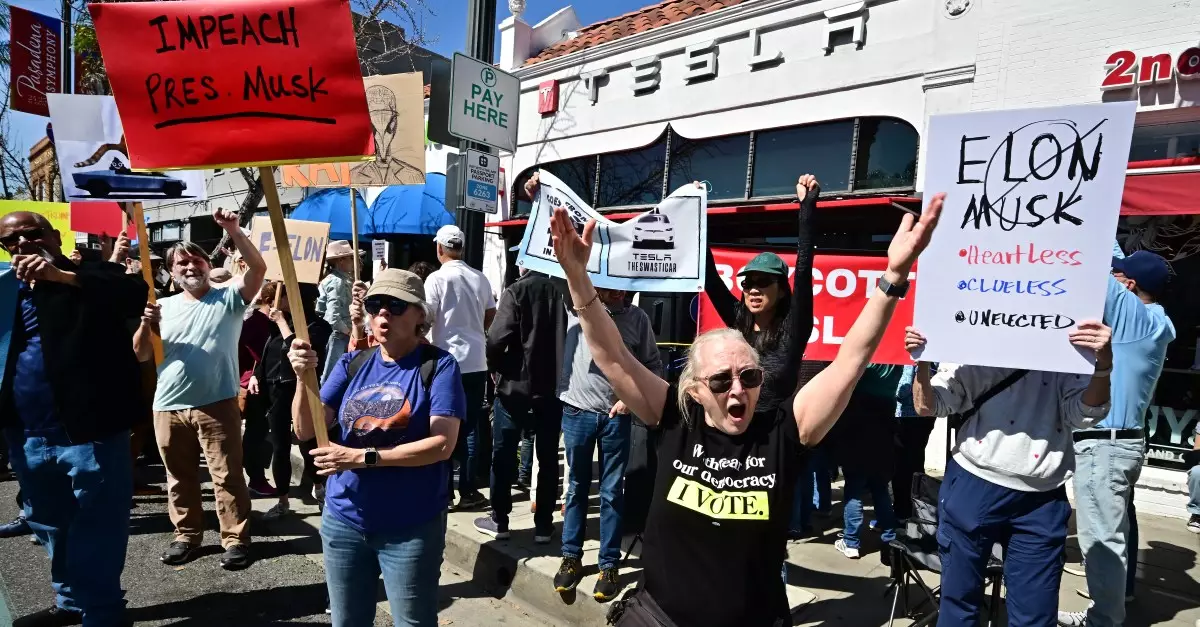On March 29th, the landscape of protest is set to shift dramatically as organizers plan an unprecedented global action targeting Tesla showrooms and Supercharger stations. With aims to host demonstrations at every one of the company’s 277 showrooms in the U.S. and others worldwide, this movement represents more than just a series of protests; it manifests deep-seated discontent with Tesla’s CEO, Elon Musk, and the direction he has taken the company and, by extension, the federal landscape of governance. What began in early February as isolated incidents of protest has now snowballed into a coordinated global effort — a testament to the ability of collective action in today’s instant-information age.
The protests have drawn attention not merely for their volume but for their intentions. Activists and organized groups have cited Musk’s controversial dismantling of federal programs and the reckless behavior associated with his social media presence as focal points of their grievances. Behind the facade of an electric vehicle revolution lies turmoil — both within Tesla’s operation and the broader socio-political environment in which it operates. The term “Tesla Takedown” aptly summarizes the sentiment of the demonstrators, who are convinced that a strong response to Musk’s corporate maneuvering is necessary.
Violence at the Crossroads of Protest
As the protests gear up, the narrative of violence looms large. Recent incidents of arson and vandalism at Tesla locations, despite being independent of the organized protests, have raised concerns. Notably, Musk and Trump have classified such actions as “domestic terrorism,” a label that creates an atmosphere of paranoia and fear surrounding peaceful demonstrations. This framing could potentially serve to delegitimize the broader message of dissent, suggesting that any form of activism risks being branded as violent or extreme.
Critics, including prominent protest organizers, have openly condemned this narrative, emphasizing that their movement is anchored in nonviolence and civil rights advocacy. The call for peaceful protests juxtaposed with law enforcement’s heavy-handed response to perceived threats indicates a complicated dynamic at play. With heavy scrutiny from government officials, including threats of severe legal repercussions for participants, the call to protest has not only become about dissenting against corporate decisions but also about safeguarding democratic rights and freedoms.
Political Ramifications and Public Sentiment
The call to action also reflects a broader political landscape increasingly hostile to activist movements. The need for protesters to consult legal advice underscores the precariousness of exercising First Amendment rights in a climate where governmental intimidation tactics loom large. Activist Lauren Regan’s comments on the potential for repressive legal challenges resonate with many activists’ fears that dissent will be met with punitive measures under the guise of maintaining order.
As activists rally behind the cause, they are not just targeting a corporation but challenging a single individual who has accumulated significant power — Elon Musk. The staggering decrease in Tesla’s stock price over recent months illustrates financial vulnerabilities within the company. Interest exists to destabilize Musk, not merely for the sake of Tesla’s product line but in light of his political affiliations and grip over federal initiatives. Micah Lee, an investigative journalist, articulated a strategy suggesting that undermining Tesla’s stock could effectively curtail Musk’s influence by forcing the CEO to liquidate assets, thereby returning power dynamics back to the public sphere.
Establishing a New Front of Activism
The mobilization of activists and ordinary citizens has become an impressive demonstration of collective resolve, one that seeks to illuminate the potential for public opinion to challenge corporate hegemony. The protests extend beyond just Tesla’s financial interests to resonate with broader societal issues such as governmental accountability, corporate ethics, and the public’s right to influence corporate governance.
The October 2023 backdrop of dissatisfaction with elite leadership fuels the protests. The participants view their activities as a critical step towards reclaiming control over democratic institutions that have seemingly been compromised. With the tech industry increasingly perceived as a monolith of influence that escapes accountability, the events of March 29th may serve as a cathartic expression of frustration and disenchantment, marking a turn in public discourse surrounding corporate practices and their implications for democracy.
As the world awaits the developments surrounding Tesla’s showrooms, the outcome of this protest could define the balance of power between large corporations and the communities they impact. What remains to be seen is whether activism can indeed exert sufficient pressure to not only hold corporate leaders accountable but also reshape the political landscape, driving home the message that collective action has the power to enact meaningful change.

